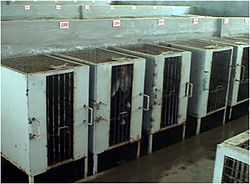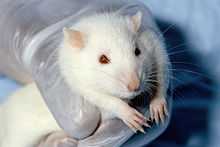Nafovanny
Nafovanny in Vietnam is the largest captive-breeding primate facility in the world, supplying long-tailed macaques (Macaca fascicularis) to animal testing laboratories, including Huntingdon Life Sciences in the UK and Covance in Germany.[2]
Background
Nafovanny was set up in 1994 by Vanny Chian Technology, a Hong Kong company, according to Reuters.[3] The company is reported to have set up a U.S.$2 million joint venture company, called Nafovanny, with Vietnam's Forestry Ministry, with the intention of creating a network of monkey farms in southern Vietnam.
Responding to criticism of the project from Dr. John Wedderburn, a former member of the RSPCA's ruling council, Daniel Chen, a director of Vanny Chain Technology, said: "We have not got a problem with that because what we are doing is very humane and it is for the welfare of human beings."[4]
Location and size
Nafovanny consists of two main farms in Long Thanh[5] near the Cambodian border, with a total area of 90,000 square meters, able to hold 30,000 monkeys. According to the British Union for the Abolition of Vivisection (BUAV), the facility also maintains satellite breeding farms on the Cambodian border, in which the BUAV alleges wild monkeys may also be held; the existence of these farms is not referenced in the company's brochure, according to the BUAV.[6]
The British Home Office has said it has no knowledge of Nafovanny satellite farms. However, it also said that "This decision was premised upon the contractual arrangements having been entered into in good-faith whilst Nafovanny was still considered to be an acceptable source, and animals already selected for onward supply to the UK. The view was taken that proper provision would be made for the welfare of these animals prior to their being shipped to the UK – and that this could be verified from the records and findings on arrival." [7]
Customers
The British government approved Nafovanny to export primates to British laboratories in 1999.[6] The British Animal Scientific Procedures Inspectorate visited Nafovanny in March 2005, and identified "shortcomings in animal accommodation and care," but since then the government has "received assurances and evidence that significant improvements have been made."[8]
According to Viet Nam News, 3,000 Nafovanny macaques were exported to the U.S. for testing purposes in 2000.[9]
See also
- Animal testing on non-human primates
- International trade in primates
Notes
- ↑ "Conditions at Nafovanny", video produced by the British Union for the Abolition of Vivisection following an undercover investigation.
- ↑ "About Nafovanny", British Union for the Abolition of Vivisection; see also "Introduction"; "Conditions"; "Wild Capture", BUAV.
- ↑ Vietnam: Hong Kong Firm Starts Vietnam Monkey Business, Reuters, December 5, 1994, link courtesy of the Australian National University, accessed February 26, 2008.
- ↑ Wallis, Keith. Vietnam: Anger at Monkey Farm Plan, South China Morning Post, December 6, 2004, link courtesy of the Australian National University, accessed February 26, 2008.
- ↑ "Animals: Scientific Procedures Inspectorate", Hansard, January 22, 2007, Column 1529W.
- ↑ 6.0 6.1 "About Nafovanny", British Union for the Abolition of Vivisection.
- ↑ "Questions on the acquisition and supply of non-human primates from overseas sources (Nafovanny)", Home Office, February 14, 2007.
- ↑ "Primates", Hansard, November 23, 2006, Column 231W.
- ↑ Tran Dinh Thanh Lam. "Kaleidoscope", Viet Nam News, June 28, 2004.
Further reading
- "Animal Research: Primates, Hansard, July 25, 2006.
| ||||||||||||||||||||||||||||||||||||||||||||||||||||||

